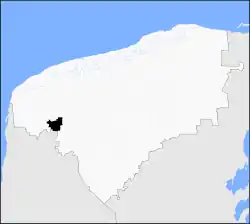Opichén | |
|---|---|
 Region 1 Poniente #055 | |
 Opichén Location of the Municipality in Mexico | |
| Coordinates: 20°32′59″N 89°46′25″W / 20.54972°N 89.77361°W | |
| Country | |
| State | |
| Mexico Ind. | 1821 |
| Yucatán Est. | 1824 |
| Government | |
| • Type | |
| • Municipal President | Carlos Enrique Ku[2] |
| Area | |
| • Total | 268.25 km2 (103.57 sq mi) |
| [2] | |
| Elevation | 10 m (30 ft) |
| Population (2010[3]) | |
| • Total | 6,285 |
| • Density | 23/km2 (61/sq mi) |
| • Demonym | Umanense |
| Time zone | UTC-6 (Central Standard Time) |
| • Summer (DST) | UTC-5 (Central Daylight Time) |
| INEGI Code | 055 |
| Major Airport | Merida (Manuel Crescencio Rejón) International Airport |
| IATA Code | MID |
| ICAO Code | MMMD |
| Municipalities of Yucatán | |
Opichén Municipality (Yucatec Maya: "inside the cave or the well") is one of the 106 municipalities in the Mexican state of Yucatán containing (268.25 km2) of land and is located roughly 75 kilometres (47 mi) south of the city of Mérida.[2]
History
There is no accurate data on when the town was founded, but it was a settlement before the conquest and was located in the chieftainship of Tutul Xiu. After colonization, the area became part of the encomienda system with various encomenderos, such as in Iñigo de Sugasti in 1607; Pedro de Santo Domingo Campos and Diego Hidalgo Bravo in 1639; Juan Esteban de Aguilar, Cristóbal Matías Hidalgo Bravo, and Juan Esteban Tello de Aguilar in 1652; and Ana de Vaneda Villegas in 1705.[2]
Yucatán declared its independence from the Spanish Crown in 1821 and in 1825 the area was assigned to the Camino Real[2] under the Maxcanú Municipality. In 1988 the area was confirmed as its own municipality.[4]
Governance
The municipal president is elected for a three-year term. The town council has four councilpersons, who serve as Secretary and councilors of public cleanliness, parks and gardens, public monuments.[5]
The Municipal Council administers the business of the municipality. It is responsible for budgeting and expenditures and producing all required reports for all branches of the municipal administration. Annually it determines educational standards for schools.[5]
The Police Commissioners ensure public order and safety. They are tasked with enforcing regulations, distributing materials and administering rulings of general compliance issued by the council.[5]
Communities
The head of the municipality is Opichén, Yucatán. The municipality has 12 other populated places[5] including Calcehtók, Cok, Kaukiriche, Mena, Ojina, San Antonio, San Esteban, Santa Rita, Santa Rosa, Siuch, and Rancho Xikim. The significant populations are shown below:[2]
| Community | Population |
|---|---|
| Entire Municipality (2010) | 6,285[3] |
| Calcehtok | 1356 in 2005[6] |
| Opichén | 4216 in 2005[7] |
Local festivals
Every year from 23 to 27 February is a celebration for the pueblo; from 8 to 12 June is the festival to honor of St. Barnabas; and at the end of August the town holds the feast of San Bartolo.[2]
Tourist attractions
- Church of San Bartolomé, built in the eighteenth century
- Chapel of the Mejorada, built in the eighteenth century
- Hacienda Calcehtoc
References
- ↑ "Diputados se hacen 'bolas' con Cotaipec" (in Spanish). Campeche, Mexico: El Expreso. 30 May 2012. Retrieved 18 August 2015.
- 1 2 3 4 5 6 7 "Municipios de Yucatán »Opichén" (in Spanish). Retrieved 18 August 2015.
- 1 2 "Mexico In Figures:Opichén, Yucatán". INEGI (in Spanish and English). Aguascalientes, México: Instituto Nacional de Estadística y Geografía (INEGI). Archived from the original on 6 May 2015. Retrieved 18 August 2015.
- ↑ "Estado de Yucatán. División Territorial de 1810 a 1995" (PDF). inegi (in Spanish). Aguascalientes, Mexico: Instituto Nacional de Estadística, Geografía e Informática. 1996. pp. 98–124. Archived from the original (PDF) on 23 December 2015. Retrieved 18 August 2015.
- 1 2 3 4 "Opichén". inafed (in Spanish). Mérida, Mexico: Enciclopedia de Los Municipios y Delegaciones de México. Retrieved 18 August 2015.
- ↑ "Calcehtok" (in Spanish). PueblosAmerica. 2005. Retrieved 18 August 2015.
- ↑ "Opichén" (in Spanish). PueblosAmerica. 2005. Retrieved 18 August 2015.
